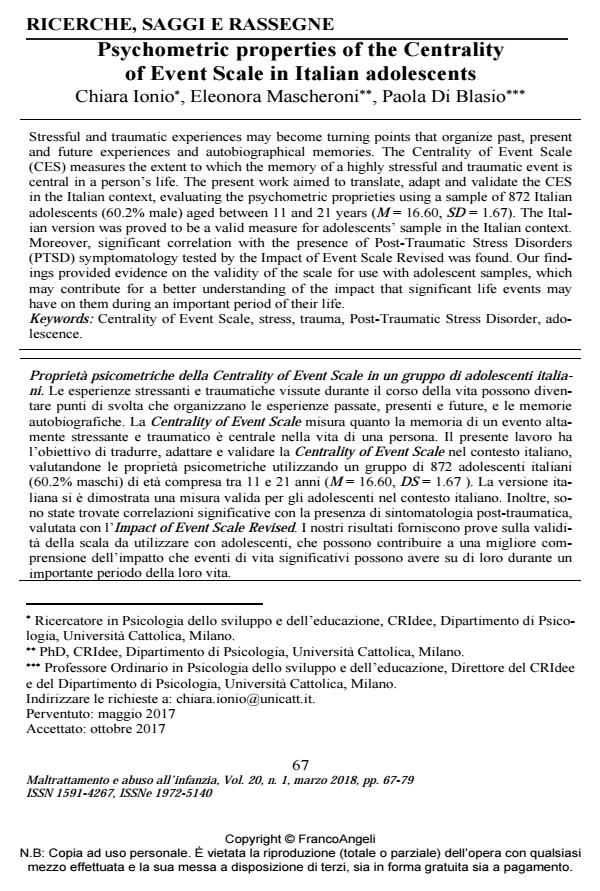Psychometric properties of the Centrality of Event Scale in Italian adolescents
Journal title MALTRATTAMENTO E ABUSO ALL’INFANZIA
Author/s Chiara Ionio, Eleonora Mascheroni, Paola Di Blasio
Publishing Year 2018 Issue 2018/1
Language English Pages 13 P. 67-79 File size 241 KB
DOI 10.3280/MAL2018-001005
DOI is like a bar code for intellectual property: to have more infomation
click here
Below, you can see the article first page
If you want to buy this article in PDF format, you can do it, following the instructions to buy download credits

FrancoAngeli is member of Publishers International Linking Association, Inc (PILA), a not-for-profit association which run the CrossRef service enabling links to and from online scholarly content.
Stressful and traumatic experiences may become turning points that organize past, present and future experiences and autobiographical memories. The Centrality of Event Scale (CES) measures the extent to which the memory of a highly stressful and traumatic event is central in a person’s life. The present work aimed to translate, adapt and validate the CES in the Italian context, evaluating the psychometric proprieties using a sample of 872 Italian adolescents (60.2% male) aged between 11 and 21 years (M = 16.60, SD = 1.67). The Italian version was proved to be a valid measure for adolescents’ sample in the Italian context. Moreover, significant correlation with the presence of Post-Traumatic Stress Disorders (PTSD) symptomatology tested by the Impact of Event Scale Revised was found. Our find-ings provided evidence on the validity of the scale for use with adolescent samples, which may contribute for a better understanding of the impact that significant life events may have on them during an important period of their life.
Keywords: Centrality of Event Scale, stress, trauma, Post-Traumatic Stress Disorder, adolescence
- Psychological factors and maternal-fetal attachment in relation to epidural choice Martina Smorti, Lucia Ponti, Tommaso Simoncini, Federica Pancetti, Giulia Mauri, Angelo Gemignani, in Midwifery 102762/2020 pp.102762
DOI: 10.1016/j.midw.2020.102762 - The invisible legacy: What is the impact of ACEs on parenting and child development? Chiara Ionio, Giulia Ciuffo, Marta Landoni, in MALTRATTAMENTO E ABUSO ALL'INFANZIA 1/2025 pp.65
DOI: 10.3280/MAL2025-001004 - The Effects of an Ecological Diversifying Experience on Creativity: An Experimental Study Alice Chirico, Sofia Carrara, Sofia Bastoni, Elena Gianotti, Andrea Gaggioli, in Frontiers in Psychology 1396/2020
DOI: 10.3389/fpsyg.2020.01396 - Dal trauma alla resilienza: una ricerca sull'expressive writing con giovani adulti Luca Milani, Alessia Stefanachi, Elena Camisasca, Paola Di Blasio, Sarah Miragoli, in RICERCHE DI PSICOLOGIA 3/2023 pp.1
DOI: 10.3280/rip2022oa14729 - The Centrality of Events Scale for Italian adolescents: Integrating traumatic experience into one’s identity and its relation to posttraumatic stress disorder symptomatology Chiara Ionio, Eleonora Mascheroni, Paola Di Blasio, in Europe’s Journal of Psychology /2018 pp.359
DOI: 10.5964/ejop.v14i2.1465 - Exploring differences in psychological aspects during pregnancy between cancer survivors and women without a history of cancer Eleonora Mascheroni, Flavia Faccio, Lucia Bonassi, Chiara Ionio, Fedro Alessandro Peccatori, Camilla Pisoni, Chiara Cassani, Giulia Ongaro, Elena Cattaneo, Giuseppe Nastasi, Gabriella Pravettoni, in Supportive Care in Cancer /2020 pp.2255
DOI: 10.1007/s00520-019-05048-w
Chiara Ionio, Eleonora Mascheroni, Paola Di Blasio, Psychometric properties of the Centrality of Event Scale in Italian adolescents in "MALTRATTAMENTO E ABUSO ALL’INFANZIA" 1/2018, pp 67-79, DOI: 10.3280/MAL2018-001005